Analyzing Attachment Theories: Impact on Behavioural Development
VerifiedAdded on 2022/12/29
|7
|1857
|40
Essay
AI Summary
This essay provides an overview of attachment theories, focusing on the emotional bond between individuals and its influence on behavior. It discusses key theories and research by John Bowlby, Mary Ainsworth, and Harry Harlow, highlighting concepts like secure and insecure attachment styles, maternal deprivation, and the critical role of early childhood experiences. The essay emphasizes the importance of love, care, and secure attachments in a child's development, noting that positive attachments foster emotional intelligence and healthy relationships, while maltreatment can lead to negative behavioral outcomes. The role of adoption and its impact on a child's attachment patterns is also explored. Ultimately, the essay underscores the significance of understanding attachment theories for promoting healthy development and positive relationships.
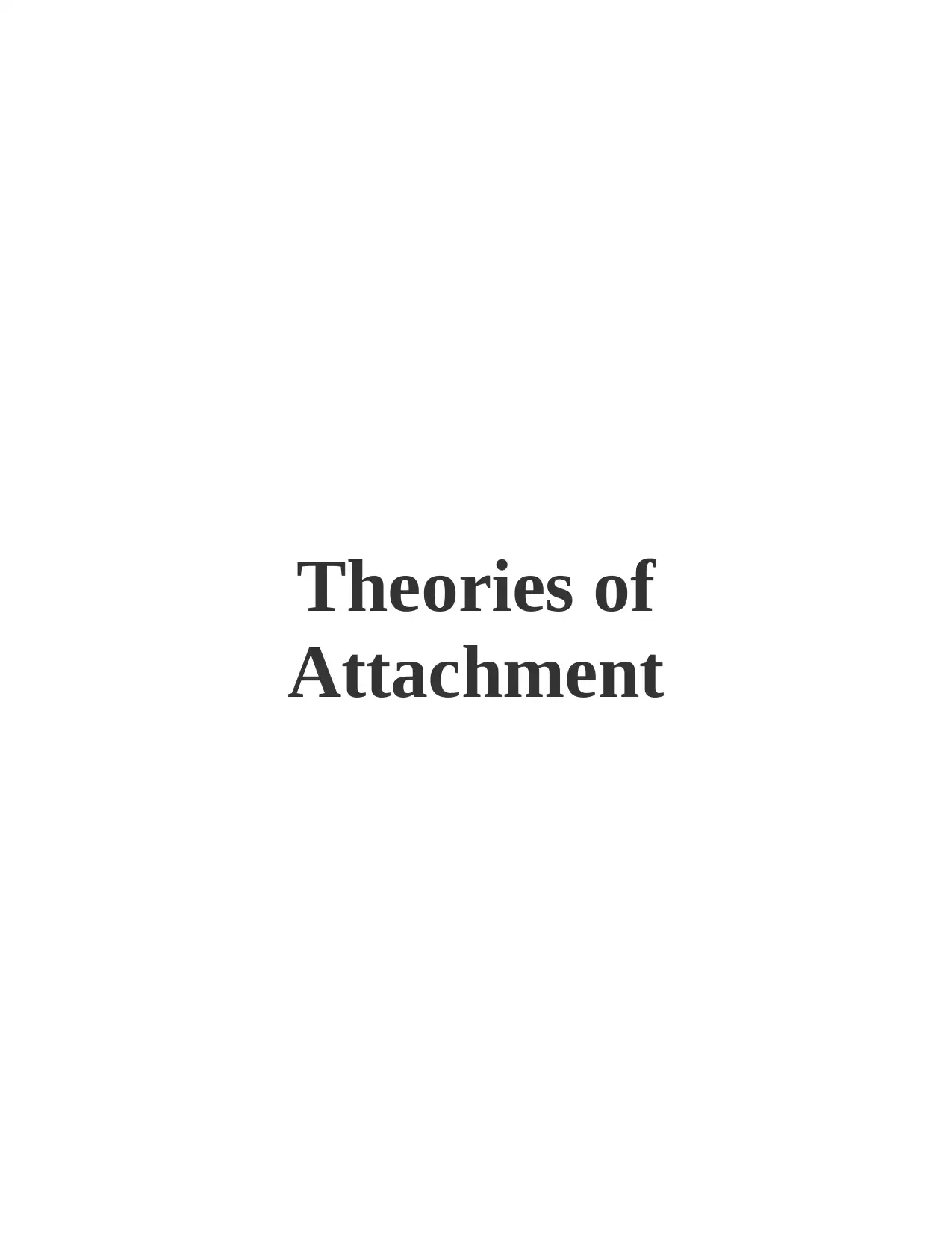
Theories of
Attachment
Attachment
Paraphrase This Document
Need a fresh take? Get an instant paraphrase of this document with our AI Paraphraser
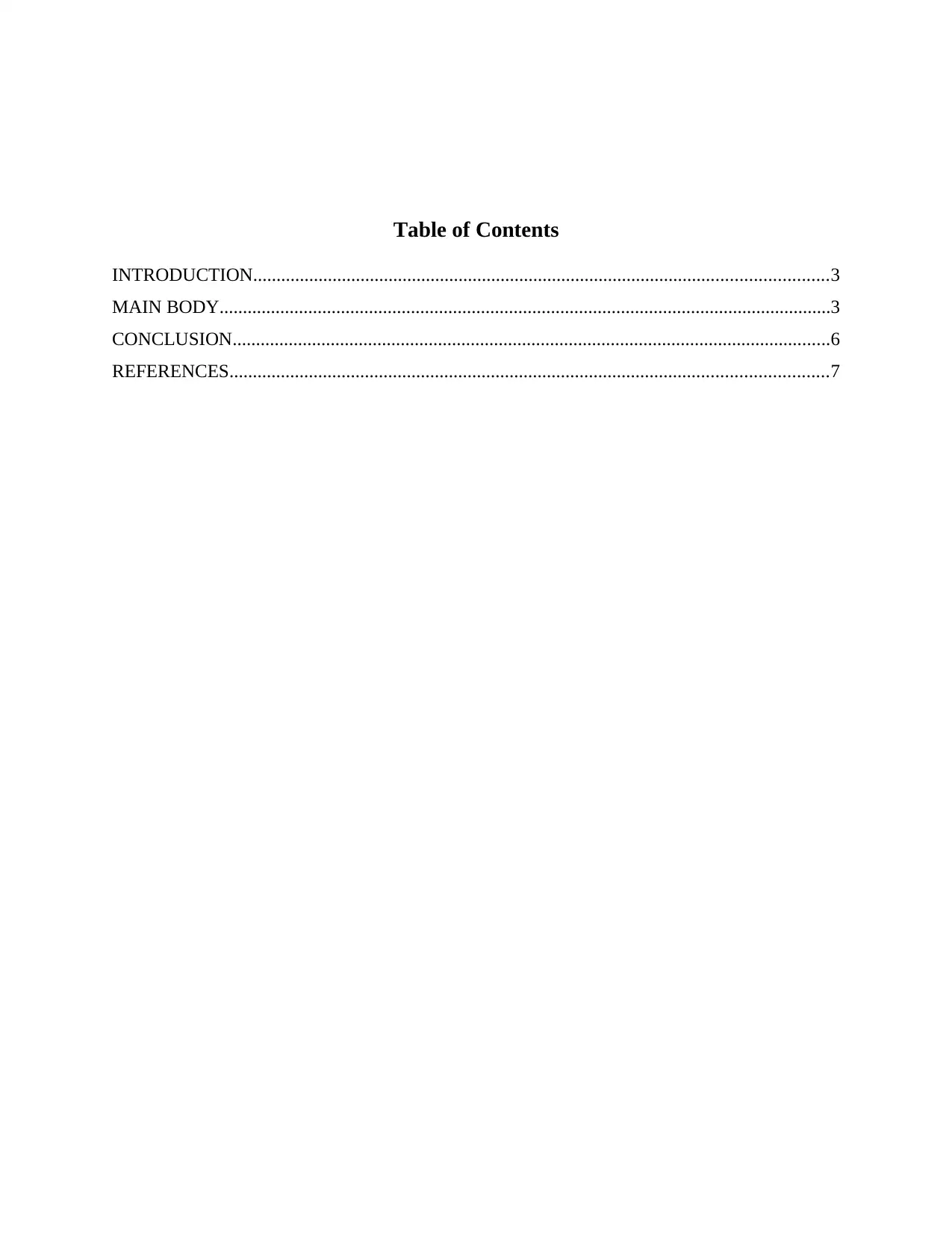
Table of Contents
INTRODUCTION...........................................................................................................................3
MAIN BODY...................................................................................................................................3
CONCLUSION................................................................................................................................6
REFERENCES................................................................................................................................7
INTRODUCTION...........................................................................................................................3
MAIN BODY...................................................................................................................................3
CONCLUSION................................................................................................................................6
REFERENCES................................................................................................................................7
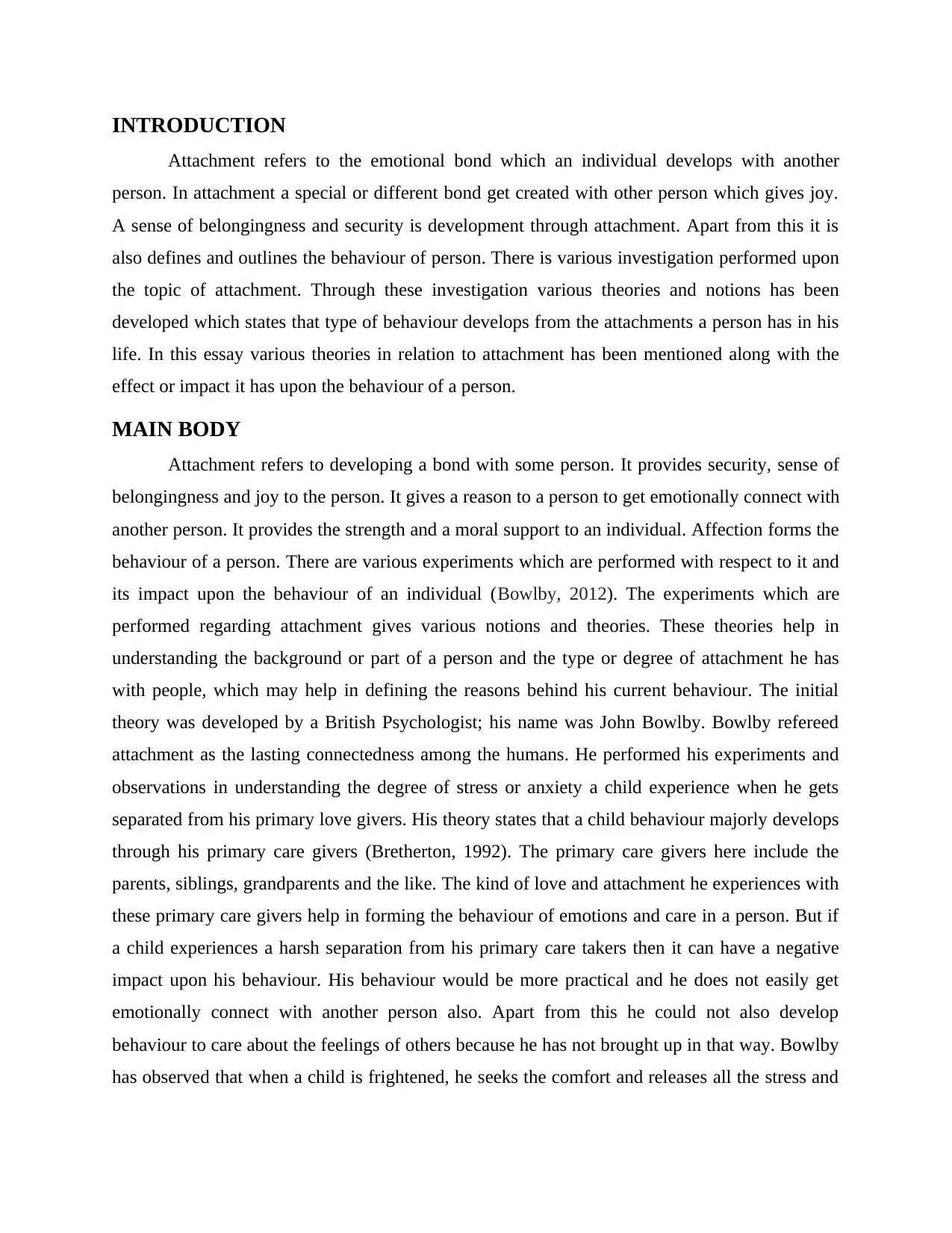
INTRODUCTION
Attachment refers to the emotional bond which an individual develops with another
person. In attachment a special or different bond get created with other person which gives joy.
A sense of belongingness and security is development through attachment. Apart from this it is
also defines and outlines the behaviour of person. There is various investigation performed upon
the topic of attachment. Through these investigation various theories and notions has been
developed which states that type of behaviour develops from the attachments a person has in his
life. In this essay various theories in relation to attachment has been mentioned along with the
effect or impact it has upon the behaviour of a person.
MAIN BODY
Attachment refers to developing a bond with some person. It provides security, sense of
belongingness and joy to the person. It gives a reason to a person to get emotionally connect with
another person. It provides the strength and a moral support to an individual. Affection forms the
behaviour of a person. There are various experiments which are performed with respect to it and
its impact upon the behaviour of an individual (Bowlby, 2012). The experiments which are
performed regarding attachment gives various notions and theories. These theories help in
understanding the background or part of a person and the type or degree of attachment he has
with people, which may help in defining the reasons behind his current behaviour. The initial
theory was developed by a British Psychologist; his name was John Bowlby. Bowlby refereed
attachment as the lasting connectedness among the humans. He performed his experiments and
observations in understanding the degree of stress or anxiety a child experience when he gets
separated from his primary love givers. His theory states that a child behaviour majorly develops
through his primary care givers (Bretherton, 1992). The primary care givers here include the
parents, siblings, grandparents and the like. The kind of love and attachment he experiences with
these primary care givers help in forming the behaviour of emotions and care in a person. But if
a child experiences a harsh separation from his primary care takers then it can have a negative
impact upon his behaviour. His behaviour would be more practical and he does not easily get
emotionally connect with another person also. Apart from this he could not also develop
behaviour to care about the feelings of others because he has not brought up in that way. Bowlby
has observed that when a child is frightened, he seeks the comfort and releases all the stress and
Attachment refers to the emotional bond which an individual develops with another
person. In attachment a special or different bond get created with other person which gives joy.
A sense of belongingness and security is development through attachment. Apart from this it is
also defines and outlines the behaviour of person. There is various investigation performed upon
the topic of attachment. Through these investigation various theories and notions has been
developed which states that type of behaviour develops from the attachments a person has in his
life. In this essay various theories in relation to attachment has been mentioned along with the
effect or impact it has upon the behaviour of a person.
MAIN BODY
Attachment refers to developing a bond with some person. It provides security, sense of
belongingness and joy to the person. It gives a reason to a person to get emotionally connect with
another person. It provides the strength and a moral support to an individual. Affection forms the
behaviour of a person. There are various experiments which are performed with respect to it and
its impact upon the behaviour of an individual (Bowlby, 2012). The experiments which are
performed regarding attachment gives various notions and theories. These theories help in
understanding the background or part of a person and the type or degree of attachment he has
with people, which may help in defining the reasons behind his current behaviour. The initial
theory was developed by a British Psychologist; his name was John Bowlby. Bowlby refereed
attachment as the lasting connectedness among the humans. He performed his experiments and
observations in understanding the degree of stress or anxiety a child experience when he gets
separated from his primary love givers. His theory states that a child behaviour majorly develops
through his primary care givers (Bretherton, 1992). The primary care givers here include the
parents, siblings, grandparents and the like. The kind of love and attachment he experiences with
these primary care givers help in forming the behaviour of emotions and care in a person. But if
a child experiences a harsh separation from his primary care takers then it can have a negative
impact upon his behaviour. His behaviour would be more practical and he does not easily get
emotionally connect with another person also. Apart from this he could not also develop
behaviour to care about the feelings of others because he has not brought up in that way. Bowlby
has observed that when a child is frightened, he seeks the comfort and releases all the stress and
⊘ This is a preview!⊘
Do you want full access?
Subscribe today to unlock all pages.

Trusted by 1+ million students worldwide
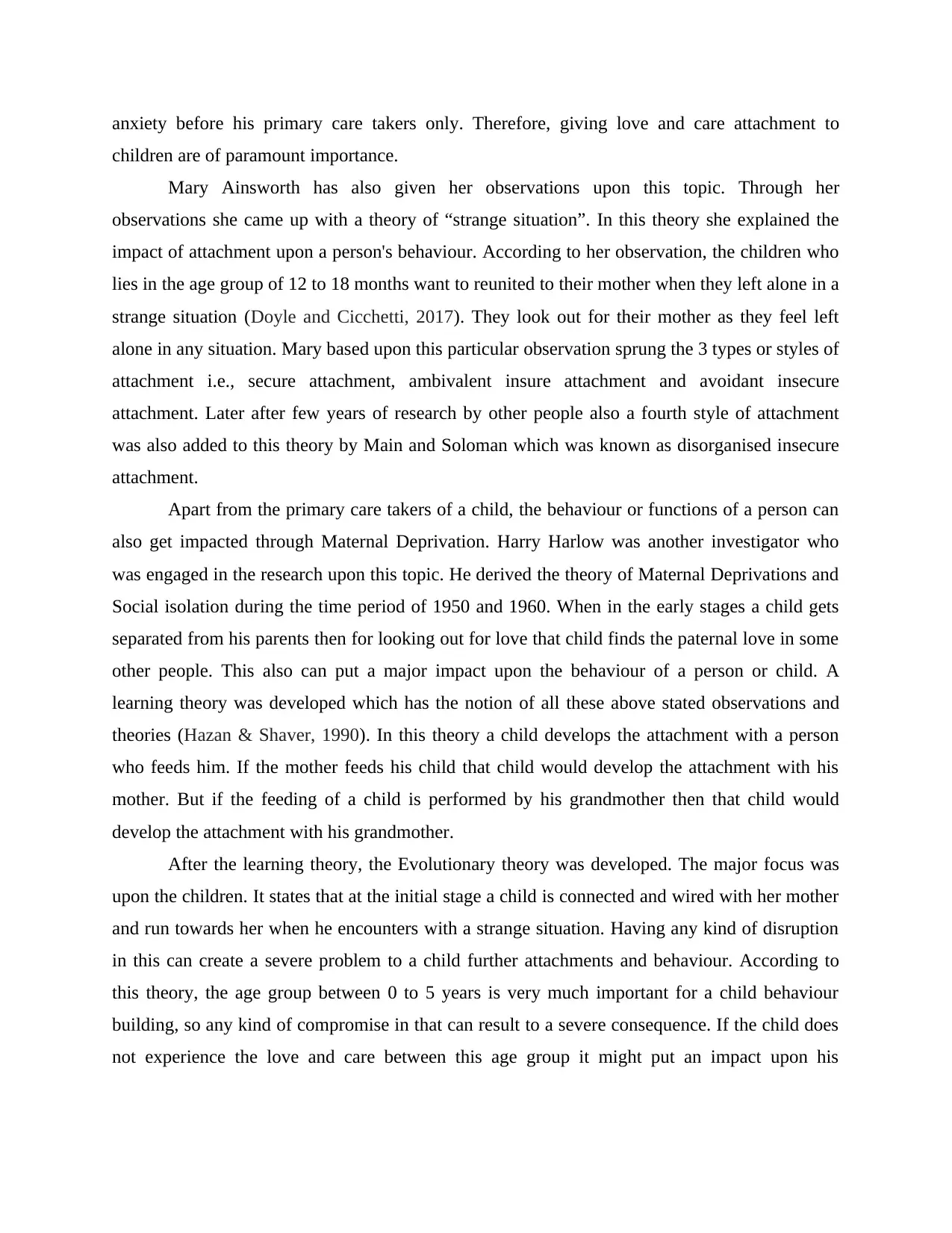
anxiety before his primary care takers only. Therefore, giving love and care attachment to
children are of paramount importance.
Mary Ainsworth has also given her observations upon this topic. Through her
observations she came up with a theory of “strange situation”. In this theory she explained the
impact of attachment upon a person's behaviour. According to her observation, the children who
lies in the age group of 12 to 18 months want to reunited to their mother when they left alone in a
strange situation (Doyle and Cicchetti, 2017). They look out for their mother as they feel left
alone in any situation. Mary based upon this particular observation sprung the 3 types or styles of
attachment i.e., secure attachment, ambivalent insure attachment and avoidant insecure
attachment. Later after few years of research by other people also a fourth style of attachment
was also added to this theory by Main and Soloman which was known as disorganised insecure
attachment.
Apart from the primary care takers of a child, the behaviour or functions of a person can
also get impacted through Maternal Deprivation. Harry Harlow was another investigator who
was engaged in the research upon this topic. He derived the theory of Maternal Deprivations and
Social isolation during the time period of 1950 and 1960. When in the early stages a child gets
separated from his parents then for looking out for love that child finds the paternal love in some
other people. This also can put a major impact upon the behaviour of a person or child. A
learning theory was developed which has the notion of all these above stated observations and
theories (Hazan & Shaver, 1990). In this theory a child develops the attachment with a person
who feeds him. If the mother feeds his child that child would develop the attachment with his
mother. But if the feeding of a child is performed by his grandmother then that child would
develop the attachment with his grandmother.
After the learning theory, the Evolutionary theory was developed. The major focus was
upon the children. It states that at the initial stage a child is connected and wired with her mother
and run towards her when he encounters with a strange situation. Having any kind of disruption
in this can create a severe problem to a child further attachments and behaviour. According to
this theory, the age group between 0 to 5 years is very much important for a child behaviour
building, so any kind of compromise in that can result to a severe consequence. If the child does
not experience the love and care between this age group it might put an impact upon his
children are of paramount importance.
Mary Ainsworth has also given her observations upon this topic. Through her
observations she came up with a theory of “strange situation”. In this theory she explained the
impact of attachment upon a person's behaviour. According to her observation, the children who
lies in the age group of 12 to 18 months want to reunited to their mother when they left alone in a
strange situation (Doyle and Cicchetti, 2017). They look out for their mother as they feel left
alone in any situation. Mary based upon this particular observation sprung the 3 types or styles of
attachment i.e., secure attachment, ambivalent insure attachment and avoidant insecure
attachment. Later after few years of research by other people also a fourth style of attachment
was also added to this theory by Main and Soloman which was known as disorganised insecure
attachment.
Apart from the primary care takers of a child, the behaviour or functions of a person can
also get impacted through Maternal Deprivation. Harry Harlow was another investigator who
was engaged in the research upon this topic. He derived the theory of Maternal Deprivations and
Social isolation during the time period of 1950 and 1960. When in the early stages a child gets
separated from his parents then for looking out for love that child finds the paternal love in some
other people. This also can put a major impact upon the behaviour of a person or child. A
learning theory was developed which has the notion of all these above stated observations and
theories (Hazan & Shaver, 1990). In this theory a child develops the attachment with a person
who feeds him. If the mother feeds his child that child would develop the attachment with his
mother. But if the feeding of a child is performed by his grandmother then that child would
develop the attachment with his grandmother.
After the learning theory, the Evolutionary theory was developed. The major focus was
upon the children. It states that at the initial stage a child is connected and wired with her mother
and run towards her when he encounters with a strange situation. Having any kind of disruption
in this can create a severe problem to a child further attachments and behaviour. According to
this theory, the age group between 0 to 5 years is very much important for a child behaviour
building, so any kind of compromise in that can result to a severe consequence. If the child does
not experience the love and care between this age group it might put an impact upon his
Paraphrase This Document
Need a fresh take? Get an instant paraphrase of this document with our AI Paraphraser
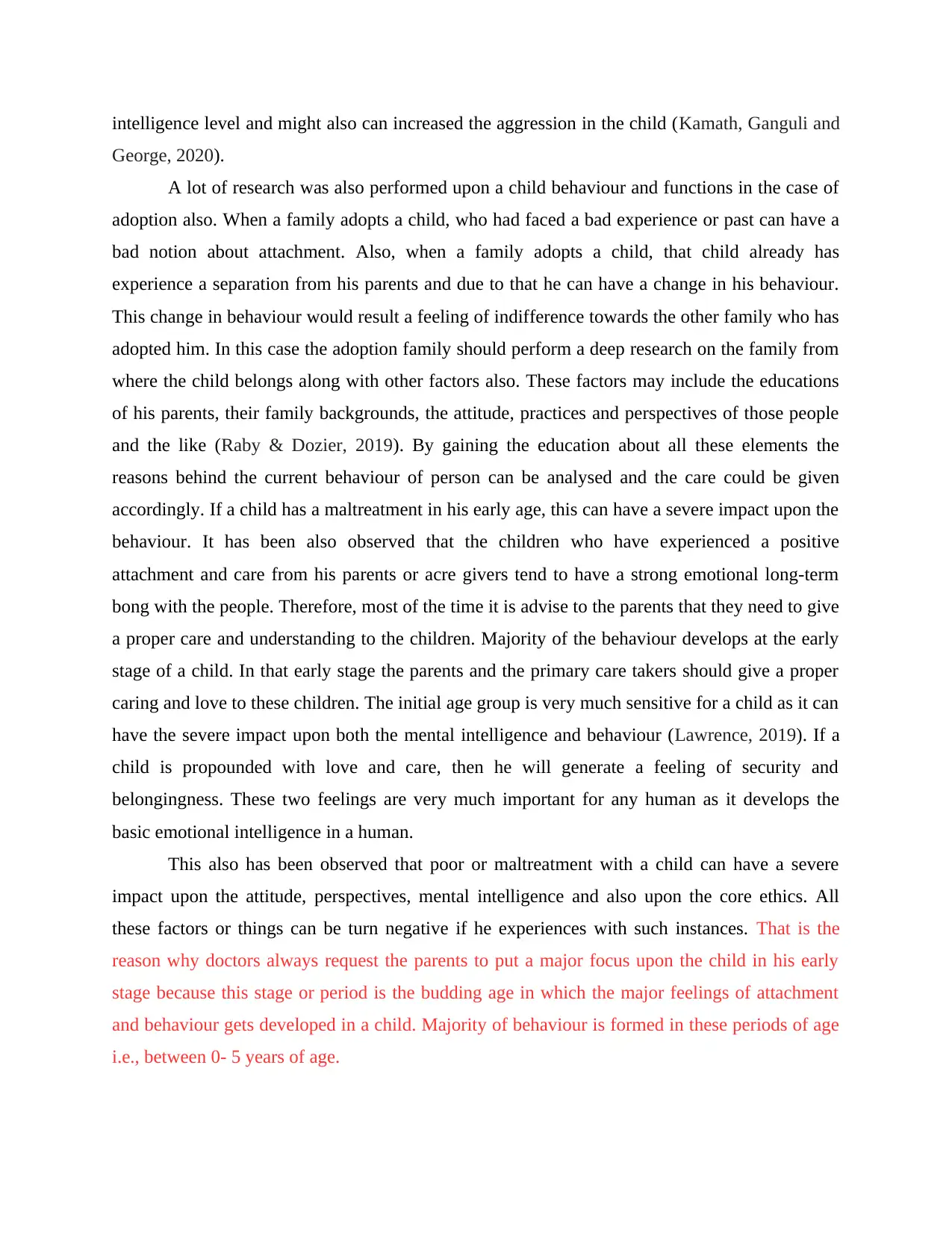
intelligence level and might also can increased the aggression in the child (Kamath, Ganguli and
George, 2020).
A lot of research was also performed upon a child behaviour and functions in the case of
adoption also. When a family adopts a child, who had faced a bad experience or past can have a
bad notion about attachment. Also, when a family adopts a child, that child already has
experience a separation from his parents and due to that he can have a change in his behaviour.
This change in behaviour would result a feeling of indifference towards the other family who has
adopted him. In this case the adoption family should perform a deep research on the family from
where the child belongs along with other factors also. These factors may include the educations
of his parents, their family backgrounds, the attitude, practices and perspectives of those people
and the like (Raby & Dozier, 2019). By gaining the education about all these elements the
reasons behind the current behaviour of person can be analysed and the care could be given
accordingly. If a child has a maltreatment in his early age, this can have a severe impact upon the
behaviour. It has been also observed that the children who have experienced a positive
attachment and care from his parents or acre givers tend to have a strong emotional long-term
bong with the people. Therefore, most of the time it is advise to the parents that they need to give
a proper care and understanding to the children. Majority of the behaviour develops at the early
stage of a child. In that early stage the parents and the primary care takers should give a proper
caring and love to these children. The initial age group is very much sensitive for a child as it can
have the severe impact upon both the mental intelligence and behaviour (Lawrence, 2019). If a
child is propounded with love and care, then he will generate a feeling of security and
belongingness. These two feelings are very much important for any human as it develops the
basic emotional intelligence in a human.
This also has been observed that poor or maltreatment with a child can have a severe
impact upon the attitude, perspectives, mental intelligence and also upon the core ethics. All
these factors or things can be turn negative if he experiences with such instances. That is the
reason why doctors always request the parents to put a major focus upon the child in his early
stage because this stage or period is the budding age in which the major feelings of attachment
and behaviour gets developed in a child. Majority of behaviour is formed in these periods of age
i.e., between 0- 5 years of age.
George, 2020).
A lot of research was also performed upon a child behaviour and functions in the case of
adoption also. When a family adopts a child, who had faced a bad experience or past can have a
bad notion about attachment. Also, when a family adopts a child, that child already has
experience a separation from his parents and due to that he can have a change in his behaviour.
This change in behaviour would result a feeling of indifference towards the other family who has
adopted him. In this case the adoption family should perform a deep research on the family from
where the child belongs along with other factors also. These factors may include the educations
of his parents, their family backgrounds, the attitude, practices and perspectives of those people
and the like (Raby & Dozier, 2019). By gaining the education about all these elements the
reasons behind the current behaviour of person can be analysed and the care could be given
accordingly. If a child has a maltreatment in his early age, this can have a severe impact upon the
behaviour. It has been also observed that the children who have experienced a positive
attachment and care from his parents or acre givers tend to have a strong emotional long-term
bong with the people. Therefore, most of the time it is advise to the parents that they need to give
a proper care and understanding to the children. Majority of the behaviour develops at the early
stage of a child. In that early stage the parents and the primary care takers should give a proper
caring and love to these children. The initial age group is very much sensitive for a child as it can
have the severe impact upon both the mental intelligence and behaviour (Lawrence, 2019). If a
child is propounded with love and care, then he will generate a feeling of security and
belongingness. These two feelings are very much important for any human as it develops the
basic emotional intelligence in a human.
This also has been observed that poor or maltreatment with a child can have a severe
impact upon the attitude, perspectives, mental intelligence and also upon the core ethics. All
these factors or things can be turn negative if he experiences with such instances. That is the
reason why doctors always request the parents to put a major focus upon the child in his early
stage because this stage or period is the budding age in which the major feelings of attachment
and behaviour gets developed in a child. Majority of behaviour is formed in these periods of age
i.e., between 0- 5 years of age.
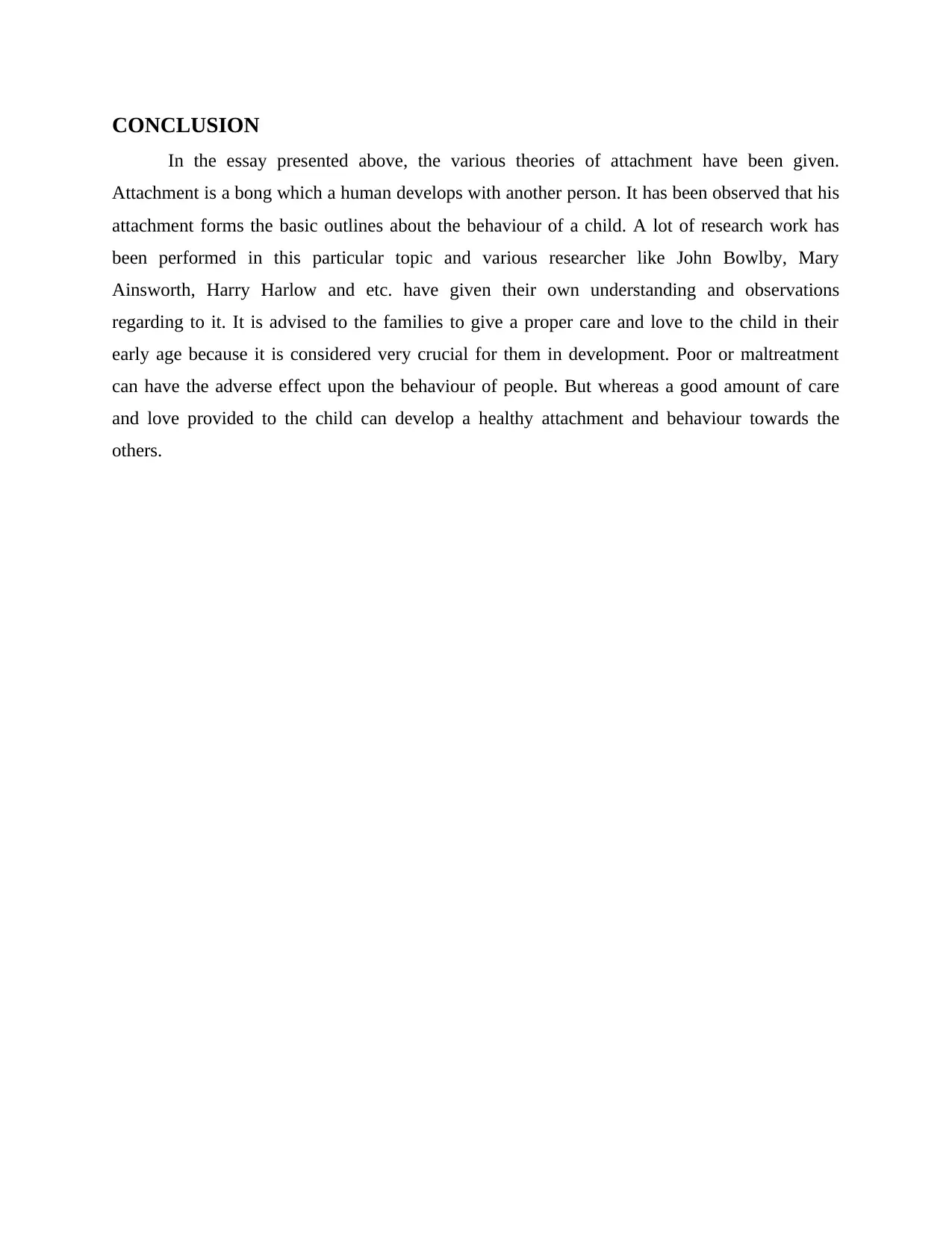
CONCLUSION
In the essay presented above, the various theories of attachment have been given.
Attachment is a bong which a human develops with another person. It has been observed that his
attachment forms the basic outlines about the behaviour of a child. A lot of research work has
been performed in this particular topic and various researcher like John Bowlby, Mary
Ainsworth, Harry Harlow and etc. have given their own understanding and observations
regarding to it. It is advised to the families to give a proper care and love to the child in their
early age because it is considered very crucial for them in development. Poor or maltreatment
can have the adverse effect upon the behaviour of people. But whereas a good amount of care
and love provided to the child can develop a healthy attachment and behaviour towards the
others.
In the essay presented above, the various theories of attachment have been given.
Attachment is a bong which a human develops with another person. It has been observed that his
attachment forms the basic outlines about the behaviour of a child. A lot of research work has
been performed in this particular topic and various researcher like John Bowlby, Mary
Ainsworth, Harry Harlow and etc. have given their own understanding and observations
regarding to it. It is advised to the families to give a proper care and love to the child in their
early age because it is considered very crucial for them in development. Poor or maltreatment
can have the adverse effect upon the behaviour of people. But whereas a good amount of care
and love provided to the child can develop a healthy attachment and behaviour towards the
others.
⊘ This is a preview!⊘
Do you want full access?
Subscribe today to unlock all pages.

Trusted by 1+ million students worldwide
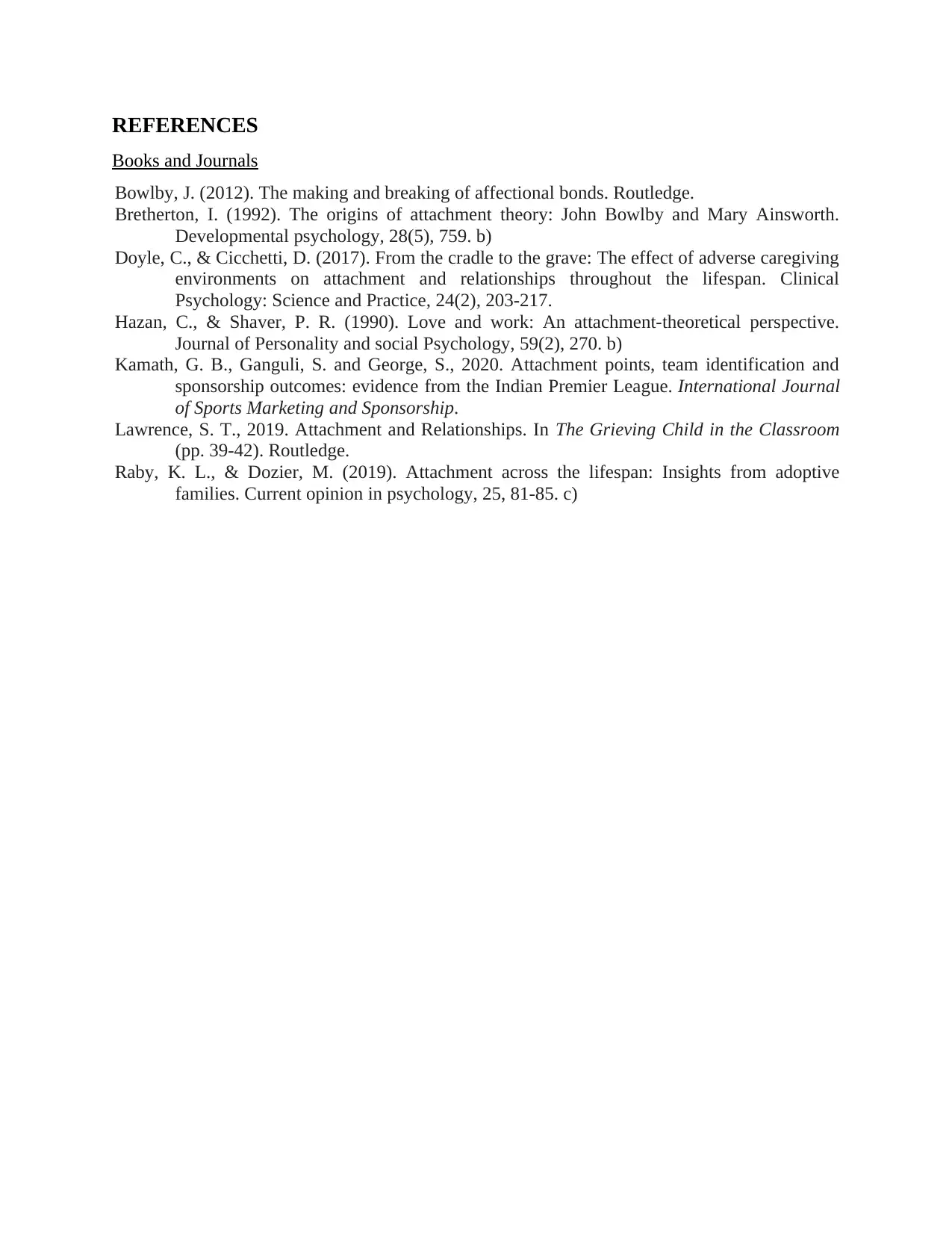
REFERENCES
Books and Journals
Bowlby, J. (2012). The making and breaking of affectional bonds. Routledge.
Bretherton, I. (1992). The origins of attachment theory: John Bowlby and Mary Ainsworth.
Developmental psychology, 28(5), 759. b)
Doyle, C., & Cicchetti, D. (2017). From the cradle to the grave: The effect of adverse caregiving
environments on attachment and relationships throughout the lifespan. Clinical
Psychology: Science and Practice, 24(2), 203-217.
Hazan, C., & Shaver, P. R. (1990). Love and work: An attachment-theoretical perspective.
Journal of Personality and social Psychology, 59(2), 270. b)
Kamath, G. B., Ganguli, S. and George, S., 2020. Attachment points, team identification and
sponsorship outcomes: evidence from the Indian Premier League. International Journal
of Sports Marketing and Sponsorship.
Lawrence, S. T., 2019. Attachment and Relationships. In The Grieving Child in the Classroom
(pp. 39-42). Routledge.
Raby, K. L., & Dozier, M. (2019). Attachment across the lifespan: Insights from adoptive
families. Current opinion in psychology, 25, 81-85. c)
Books and Journals
Bowlby, J. (2012). The making and breaking of affectional bonds. Routledge.
Bretherton, I. (1992). The origins of attachment theory: John Bowlby and Mary Ainsworth.
Developmental psychology, 28(5), 759. b)
Doyle, C., & Cicchetti, D. (2017). From the cradle to the grave: The effect of adverse caregiving
environments on attachment and relationships throughout the lifespan. Clinical
Psychology: Science and Practice, 24(2), 203-217.
Hazan, C., & Shaver, P. R. (1990). Love and work: An attachment-theoretical perspective.
Journal of Personality and social Psychology, 59(2), 270. b)
Kamath, G. B., Ganguli, S. and George, S., 2020. Attachment points, team identification and
sponsorship outcomes: evidence from the Indian Premier League. International Journal
of Sports Marketing and Sponsorship.
Lawrence, S. T., 2019. Attachment and Relationships. In The Grieving Child in the Classroom
(pp. 39-42). Routledge.
Raby, K. L., & Dozier, M. (2019). Attachment across the lifespan: Insights from adoptive
families. Current opinion in psychology, 25, 81-85. c)
1 out of 7
Related Documents
Your All-in-One AI-Powered Toolkit for Academic Success.
+13062052269
info@desklib.com
Available 24*7 on WhatsApp / Email
![[object Object]](/_next/static/media/star-bottom.7253800d.svg)
Unlock your academic potential
Copyright © 2020–2025 A2Z Services. All Rights Reserved. Developed and managed by ZUCOL.





